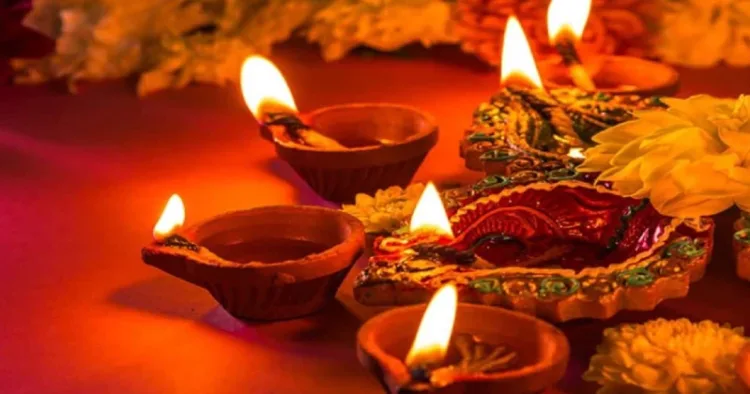Deepawali is one of the most popular and loved festivals in India. It is known as the “Festival of Lights” and celebrates the victory of light over darkness and good over evil. Deepawali is filled with joy, bright lights, sweets, and fireworks, transcends religious and regional boundaries, uniting people in celebration. While many relate Deepawali with the return of Bhagwan Ram to Ayodhya, the festival’s significance is multi-dimensional and is steeped in historical contexts. Here, let us explore the rich reasons behind the celebration of Deepawali.
Historical significance of the festival
1. The Return of Bhagwan Ram to Ayodhya
The most famous story connected to Deepawali is about Bhagwan Ram returning to his home, Ayodhya, after spending 14 years in exile. His return was celebrated by the people of Ayodhya with joy and by lighting lamps all over the city.According to the Hindu epic Ramayana, Ram, the prince of Ayodhya, was exiled due to a promise his father, King Dasharatha, had made to one of his queens, Kaikeyi. Along with his wife Sita and brother Lakshmana, Ram spent 14 years in exile, during which he fought and defeated king Ravana, who had kidnapped Sita.
When Bhagwan Ram returned to Ayodhya after defeating Ravana, the people of his kingdom celebrated by lighting oil lamps (diyas) everywhere. This joyful event symbolised the victory of good (Ram) over evil (Ravana) and light over darkness. Even today, people continue the tradition of lighting lamps during Deepawali, representing the removal of ignorance and the arrival of wisdom.
2. The Story of Narakasura
Another significant legend tied to Deepawali is the story of the demon king Narakasura. In South India, Deepawali is celebrated to remember the day Bhagwan Krishna defeated the evil king Narakasura. According to the history, Narakasura, who had grown powerful and arrogant, kidnapped and imprisoned 16,000 women. Bhagwan Krishna, along with his wife Satyabhama, battled and killed Narakasura, freeing the women and restoring peace. This event symbolises the victory of good over evil, and Deepawali is celebrated in southern regions as a day of deliverance.
3. The Worship of Ma Lakshmi
Lakshmi Puja is another key component of Deepawali celebrations. Lakshmi ji is worshiped for wealth and prosperity on this day. According to legend, during the churning of the cosmic ocean (Samudra Manthan), the Ma Lakshmi emerged from the ocean on the night of Deepawali. Her appearance is considered auspicious, and many worship her to seek blessings for wealth and well-being in the coming year.
Deepawali is also celebrated at the end of the harvest season in many parts of India. It’s a time when people thank Ma Lakshmi for the good crops and pray for prosperity and success in the future.
4. The Story of Bhagwan Vishnu and King Bali
Another lesser-known legend involves Bhagwan Vishnu in his Vamana avatar and King Bali, a generous but ambitious demon king. King Bali’s growing power threatened the balance of the universe, and Bhagwan Vishnu took the form of a dwarf (Vamana) to curb his power. During the festival of Deepawali, especially in the states of Kerala and Karnataka, it is believed that Vishnu pushed Bali to the netherworld but allowed him to return to Earth once a year to light lamps and bless his kingdom. This event is observed as Bali Pratipada, which is part of the Deepawali festivities in some regions.
5. The Origin of Deepawali in Ancient India
The celebration of Deepawali can be traced back to ancient India, where it was likely a harvest festival. The post-monsoon period, with the crops harvested and stored, was a time for celebration. Deepawali may have started as a means of thanking the gods for the successful harvest and for seeking blessings for future prosperity.
Over time, these harvest festivals merged with religious rituals and the celebration of historical events, creating the vibrant festival we now know as Deepawali. The lighting of lamps, distribution of sweets, and community celebrations can be seen as a cultural expression of abundance, joy, and collective well-being.
According to Jain scriptures, Mahavira’s soul was freed from the cycle of birth and death on the night of Deepawali. Jains light lamps to symbolise the light of knowledge and the dispelling of ignorance. The festival is also a reminder to follow the teachings of Mahavira truth, non-violence, and simplicity.
For Sikhs, Deepawali is celebrated as Bandi Chhor Divas, marking the day Guru Hargobind, the sixth Sikh Guru, was released from imprisonment by the Mughal emperor Jahangir. According to Sikh tradition, Guru Hargobind refused to leave the prison unless 52 other Hindu kings imprisoned by the emperor were also freed. On Deepawali, these rulers were released along with Guru Hargobind, and he returned to Amritsar, where the Golden Temple was illuminated with lamps to welcome him. Sikhs continue to celebrate this day as a symbol of justice, freedom, and the triumph of righteousness.
Some Buddhists, particularly Newar Buddhists in Nepal, celebrate Deepawali (or “Tihar”) to honor King Ashoka’s conversion to Buddhism. King Ashoka, a ruler known for his violent conquests, experienced a deep spiritual transformation after the battle of Kalinga. He embraced Buddhism and non-violence, spreading the message of peace throughout his empire. This transformation is honored during Deepawali by some Buddhist communities as a celebration of peace, compassion, and the rejection of violence.
Deepawali’s significance lies in its diverse historical, cultural roots. It is a festival that celebrates not only the victory of good over evil but also the values of unity, prosperity, and enlightenment. Whether it is the return of Bhagwan Ram, the victory over Narakasura, or the spiritual enlightenment of Mahavira, Deepawali offers deep lessons that resonate across religions and communities.
The lighting of diyas, bursting of fireworks, and sharing of sweets during Deepawali are symbolic gestures of warmth, joy, and togetherness. Across centuries, this festival has remained a reminder that no matter how challenging or dark life may seem, hope, goodness, and light will always prevail.



















Comments